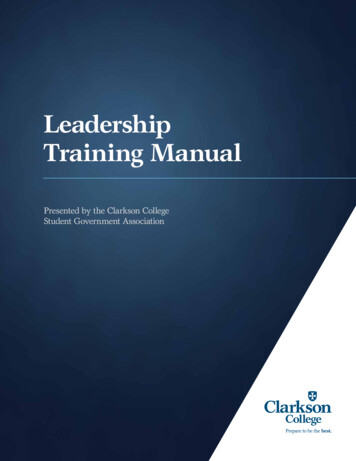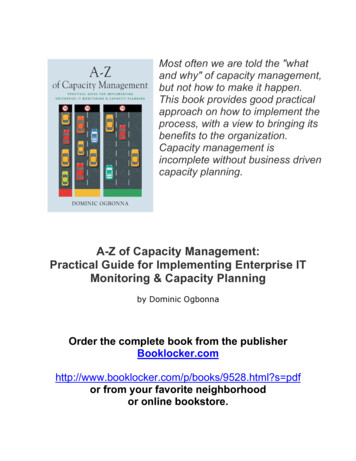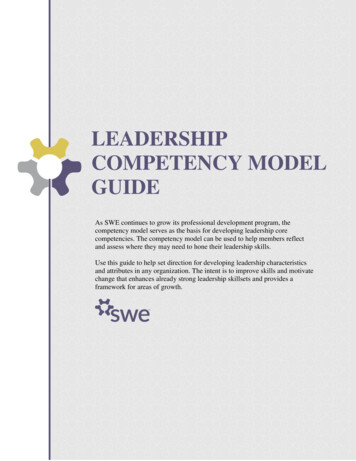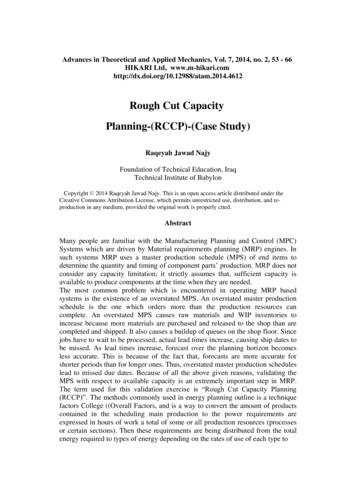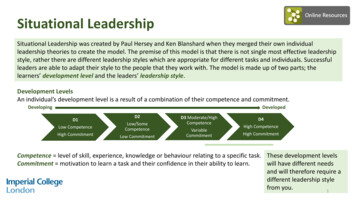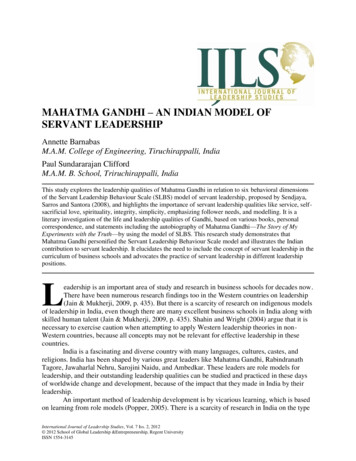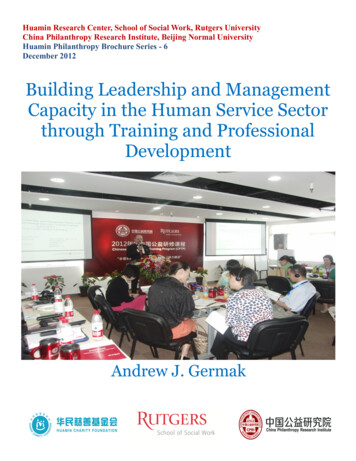
Transcription
Huamin Research Center, School of Social Work, Rutgers UniversityChina Philanthropy Research Institute, Beijing Normal UniversityHuamin Philanthropy Brochure Series - 6December 2012Building Leadership and ManagementCapacity in the Human Service Sectorthrough Training and ProfessionalDevelopmentAndrew J. Germak
IntroductionEffective training programs and professional development initiatives areparamount to enhancing the capacity of employees in today’s humanservice sector. The sector, which includes both public human serviceagencies and non-governmental organizations, provides services tosome of society’s most vulnerable individuals, families, and communities. Yet, the sector is financially constrained and presently experiencingincreased demand, and organizations are hard-pressed to allocate fundstoward training and professional development. For leaders and managers in the human services, ongoing training and development is essential to sustaining mission and impact; often impact starts with the effective leadership of an organization, which requires ample preparationand training.This brochure: Explores current challenges faced by the human service sector workforce. Provides case examples of innovative training and professional development programs in the United States. Makes suggestions for future research and practice in the area oftraining and professional development in the human service sector.1
Leadership and ManagementTraining and ProfessionalDevelopment Leadership training and professional development activities have become increasingly importantfor public and non-government (NGO) human service organizations as a result of the surge in demand for human services across the United States. Unfortunately, as rising public need and financial constraints make the effective managementand cultivation of resources ever more important, anxieties grow over whether human service organizations can meet the growing demand for talent brought by overall sector growth and an approaching boom in executive-level retirements. While labor market forces may mitigate the anticipated crisis, the recent economic climate is likely to have exacerbated a growing demand for qualified leadership in human services. Training and professional development is widely recognized as an important component of preparing new leaders in the public and NGO human service sector. In addition to recruitment and management compensation reforms, scholars and organizationscontinually prioritize investment in existing leadership capacities through professional development activities, such as structured continuing education programs.Managers and leaders must continually update their skills to remaineffective at human service delivery.2
Importance of Human ServiceManagement, Leadership Training,and Professional DevelopmentThere have been recent calls for human service professionals and agencies to substantially invest in professional development as the evolving nature of service functions, settings, and delivery methods, demand that leaders continually update theirknowledge skills and abilities. With regard to challenges in management and leadership in the human services, the rising marketization of the public sector and the emergence of the New Public Management orientationhave led to the infusion of business practices into the work of human service management andleadership. This requires that many leaders need to partake in continuing professional education or another form of training to update their skill set. Continuing education, training, and professional development is conceptualized as a lifelonglearning process for professionals beyond academic degrees, which aims to improve skills andknowledge for specific occupations. This form of learning can take the form of a:- Workshop- Lecture- Training- Short-term non-degree certificate programSuch programs are considered a necessary part of professional career advancement and a mechanism to deliver improved outcomesfor both organizations and service beneficiaries. Professional development courses targeted to mid- to senior-level professionals may be the besthope at curbing short-term deficits in leadership capacities in the human service sector. Moreover, opportunities for training may be especially useful for aspiring leaders with backgrounds insocial work, theology, and the humanities.Strengthening professional development programs can benefit thehuman service sector as a whole by helping to retain talented individualsin the field and preparing them to take on future leadership roles.3
Importance of Human ServiceManagement, Leadership Training,and Professional DevelopmentThe human service sector lacks experience with an established model of leadershipdevelopment, but several recommendations have been made by scholars:1Focus on complexities of multilevel governance and blurred boundaries and relationships across complex inter-organizational settings.2Combine generic and context-specific elements.3Create structured progressions, focused particularly on early to midcareer development.4Create challenging content that is applied and informed by psychologyof adult development.5Be part-time, “blended,” and accredited.Whether educational programs should consider organizational needs in developinglearning content is debated in higher education generally; however, at least for management training and professional development programs, this focus seems to serveboth students and employers well.4
Examples of Effective Trainingand Professional Development Programsin Human Service Managementand LeadershipManagement Fellows ProgramThe Department of Children and Families gathered to begin working on a unique capacity-buildingproject that is focused specifically on developing and enhancing their management and leadershipskills. With training modules based on Human Services Leadership Competencies, the project willextend over 16 months. Utilizing various methods of delivery, participants will work throughoutthis training and professional development program on strengthening their personal and professional management and leadership skills in order to improve program outcomes.To ensure that the program is highly relevant to their work, participants will take part in an assessment of the competencies and will rate the importance and relevance of the competencies to theirown work, and will complete a more detailed self-assessment and prepare an individual development plan. Throughout the year, participants will receive individualized support and guidancefrom an executive coach and selected mentors in the field of organizational management.Through a monthly lecture series, participants will be introduced to national experts in various aspects of organizational management and will attend live and virtual discussions focused on variouscompetencies. The goal for each of the participants is to apply the information they receive directlyto their own work settings to improve program outcomes.In addition to attending these training sessions, participants will participate in group problemsolving activities, each becoming a member of a management cluster tasked with completing a capstone project, designed to solve a real and critical organizational challenge.Rutgers University School of Social Work’s Institute forFamilies will prepare a comprehensive evaluation ofthe entire training program at the conclusion of theproject. All participants will receive the Certified SocialWork Manager credential upon successful completionof the program.5
Examples of Effective Trainingand Professional Development Programsin Human Service Managementand LeadershipSocial Work Leadership Certificate ProgramThe Social Work Leadership Certificate Program is a professional development project currently inprogress and sponsored by the National Association of Social Workers New Jersey Chapter(NASW-NJ) with the overall objective of developing chapter leadership and the prospects foremerging and future leaders. The program will consist of five day-long workshops and three onehour online trainings. The topics for the day-long workshops include: Leadership Skills for Social WorkersCommunication and Professional Development for LeadersCreating Diversity and Social JusticeUnderstanding Transparency in Management and GovernanceManaging Successful Partnerships and CollaborationsIn addition, participants will complete a personalized learning project to provide the opportunityto immediately use the concepts and skills they have learned.The project is structured as follows: The in-person workshop series will be composed of five day-long workshops delivered over asix-hour time period conducted at a centralized training location. These training sessions arescheduled to occur monthly. The online component will consist of up to three one-hour webinars. Each workshop and webinar will feature one or more nationally recognized subject matter experts (NSWM consultants)well-versed in specific areas of leadership development.This training program will accommodate up to 35 participants total. The Institute for Families willdistribute an evaluation tool to collect evaluation information at the conclusion of each workshop.The analysis of the collected information will be provided to NASW-NJ and could be used to develop future training programs.6
Examples of Effective Trainingand Professional Development Programsin Human Service Managementand LeadershipNonprofit and Public Management Certificate ProgramThis certificate program is designed to build and enhance the knowledge, skills and competenciesof current and future leaders of nonprofit and public human service organizations and to assistthem in strategically managing the many challenges presented in today’s human services environment. The required workshops consist of the following themes followed by workshop sub-topics:Qualities of LeadershipManagement of Budgeting and FinanceManaging ChangeHuman Resources ManagementStrategic ManagementThe Nonprofit and Public ManagementCertificate Program also requires thatparticipants complete three electivecourses offered on a variety of management-related topics. This certificate canbe self-paced. That is, a participant cantake the required eight courses – fivefoundation and three electives – at timesof his or her choosing. This providesflexibility for working professionals thatseek to further their skills in management and leadership.7
Examples of Effective Trainingand Professional Development Programsin Human Service Managementand LeadershipSocial Innovation InstituteThe New Jersey Social Innovation Institute is a training program for social innovators and enterprising non-profit organizations developing business plans and investment proposals for new social businesses enterprises. Special consideration will be given to participants that are significantjob creators for New Jersey residents.The objective of the first statewide Social Innovation Institute was to empower new social entrepreneurs to develop their venture ideas. In January 2012, 15 teams of social entrepreneurs wereselected to participate in the institute. These teams completed a six-month initiative that includedsocial entrepreneur-ship training, mentoring and technical assistance in partnership with the Support Center for Nonprofit Management in New York and the New Jersey Department of Labor.Specifically, the initiative: Provided training, mentoring and technical assistance to participantsFacilitated networking with potential investors, experienced business leaders and individualentrepreneurs who were interested in engaging in social venture initiatives in New JerseyDeveloped actionable business plans and investment proposals for local and national foundations and social investorsSupported the efforts of nonprofit organizations and social entrepreneurs who were activelyengaged in social and environmental problem solving through enterprise especially throughjob creation.8
ResourcesBan, C., Drahnak-Faller, A., & Towers, M. (2003). Human Resource Challenges in Human Service andCommunity Development Organizations: Recruitment and Retention of Professional Staff,Review of Public Personnel Administration, 23(2), 133-153.Bell, J., Moyers, R., & Wolfred, T. (2006). Daring to lead 2006: A national study of nonprofit executiveleadership. California: CompassPoint Nonprofit Services and Washington, D.C: Meyer Foundation.Bell, J., Moyers, R., & Wolfred, T. (2006). Daring to Lead 2006: A national study of nonprofit executiveleadership – A joint project of Compass Point Nonprofit Services and the Meyer Foundation. SanFrancisco, CA, San José, CA, Washington, D.C.: CompassPoint Nonprofit Services and The MeyerFoundation.Burlingame, D.F. (2009). Nonprofit and philanthropic studies education: the need to emphasizeleadership and liberal arts. Journal of Public Affairs Education. 15(1), 59-67.Cantor, J. A. (2006). Lifelong learning and the academy: the changing nature of continuing education.ASHE Higher Education Report, 32(2), 1-100.County Welfare Directors Association of California & California State Association of Counties(2009). Human services in a time of economic crisis: An examination of California’s safety-net programs and related economic benefits for communities. Accessed March 22, 2012 from 409.pdf.Coyle, J., and Carter, I. (2011). Can continuing education curricula effectively teach professionals? A casefor using a curriculum assessment tool for initial and ongoing evaluation. The International Journalof Continuing Social Work Education, 14(1), 19- 26.Dunleavy, P., & Hood, C. (1994). From old public administration to new public management. PublicMoney and Management, 14(3), 9-16.Ferlie, E. (2002). Quasi strategy: Strategic management in the contemporary public sector. In A. Pettigrew,H. Thomas, and R. Whittington (Eds.), Handbook of Strategy and Management (pp. 279-298).Thousand Oaks, CA: Sage Publications.Forbes Funds (2004). Look Here! Attracting and Developing the Next Generation of Nonprofit Leaders.Retrieved from June 10, 2012, retrieved from http://www.forbesfunds.orgGuo, C., Brown, W.A., Ashcraft, R.F., Yoshioka, C.F., & Dong, H.D. (2011). Strategic Human ResourcesManagement in Nonprofit Organizations. Review of Public Personnel Administration, 31(3), 248269.Harms, W. (2008, December 11). An economic downturn impacts social services’ ability to aidpoor. The University of Chicago Chronicle, 28(6). Accessed March 15, 2012 from http://chronicle.uchicago.edu/081211/ poor.shtml.Harvey, L. (2001). Defining and measuring employability. Quality in Higher Education 7(2), 97, 109.Harvey, L. (2005). Embedding and integrating employability. New Directions for Institutional Research,128, 13-28.9
ResourcesJohnson, J.L. (2009). The Nonprofit Leadership Deficit: A Case for Optimism. Nonprofit Managementand Leadership, 19(3), 286-304.Koch, R. (1999). New public management and management education: Foundations of successfulmanagement reform. Australian Journal of Public Administration, 58(3), 97-100.Linscott, K.G. (2011). Filling the Leadership Pipeline: Driving Forces and Their Effect on the NextGeneration of Non-profit Leaders. SPNHA Review, 7(1), 31-50Nonprofit Finance Fund (2011). Nonprofit finance fund 2011 survey: America’s nonprofits struggle tomeet fast-climbing demand for services. Retrieved March 18, 2011, from / nonprofit-finance-fund survey .Nonprofit Quarterly (2007). How Do Employers Weigh a Candidate’s Degree in Nonprofit ManagementWhen Hiring? Nonprofit Quarterly Education Supplement, 35–36.Paton, R., Mordaunt, J., and Cornforth, C. (2007). Beyond nonprofit management education: leadershipdevelopment in a time of blurred boundaries and distributed learning. Nonprofit & VoluntarySector Quarterly, December Supplement, 36(4), 148-162.Preston, M. S. (2005). Child welfare management training: Towards a pedagogically soundcurriculum. Administration in Social Work, 29(4), 89-111.Solomon, J., & Sandahl, Y. (2007). Stepping Up or Stepping Out: A Report on the Readiness of NextGeneration Leaders. Young Nonprofit Professionals Network. Retrieved June 25, 2012, fromhttp://ynpn.org/wp-content/uploads/ stepping up.pdfStevens, P. (1996). What works and what does not in career development programmes. CareerDevelopment International, 1(1), 11-18.The Pennsylvania Budget and Policy Center (2012). Accessed March 31, 2012 athttp://pennbpc.org/public-safety-net.Tierney, T. J. (2006). The leadership deficit. Stanford Social Innovation Review, 4(2), 26-35.Webster-Wright, A. (2009). Reframing Professional Development Through Understanding AuthenticProfessional Training. Review of Educational Research, 79(2), 702-739.Wilton, N. (2008). Business graduates and management jobs: an employability match made in heaven?Journal of Education and Work, 21(2), 143-158.10
Building Leadership and ManagementCapacity in the Human Service Sectorthrough Training and ProfessionalDevelopmentHuamin Philanthropy Brochure Series - 6Huamin Research Center, School of Social Work, Rutgers University390 George Street, Room 503, New Brunswick, NJ, 08901, USAChina Philanthropy Research Institute, Beijing Normal University19 XinJie Kou Wai Street, Room 1003A.,Haidian District, Beijing, 100875, China
for public and non-government (NGO) human service organizations as a result of the surge in de-mand for human services across the United States. Unfortunately, as rising public need and financial constraints make the effective management and cultivation of resources ever more important, anxie


